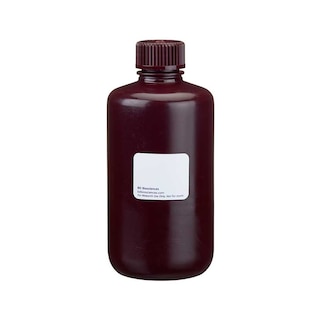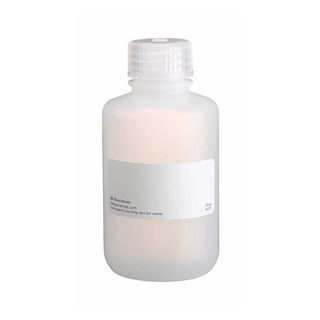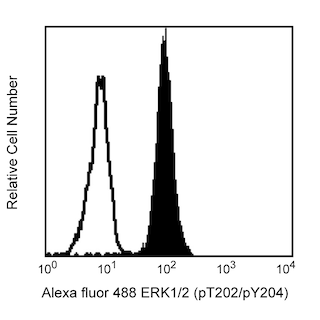Old Browser
This page has been recently translated and is available in French now.
Looks like you're visiting us from {countryName}.
Would you like to stay on the current country site or be switched to your country?



.png)

LEFT PANEL: Analysis of 4EBP1 (pT69) in human peripheral blood monocytes. Human peripheral blood mononuclear cells (PBMC) were either treated with 100 μM LY294002 (Sigma, Cat. No. L-9908) for 1 hour at 37ºC (shaded histogram) or untreated (open histogram). The PBMC were fixed (BD Cytofix™ buffer, Cat. No. 554655) for 10 minutes at 37°C, permeabilized with BD Phosflow™ Perm Buffer III (Cat. No. 558050) on ice for 30 minutes, and then stained with PE Mouse anti-4EBP1 (pT69). For data analysis, monocytes were selected by their scatter profile. The data demonstrates that the level of phosphorylation of 4EBP1 decreases when protein kinase activity is inhibited by the treatment. Flow cytometry was performed on a BD FACSCalibur™ flow cytometry system. RIGHT PANEL: The specificity of mAb M34-273 was confirmed by western blot analysis (right panel) using unconjugated polyclonal anti-4EBP1 (Cell Signaling Technology, Cat. No. 9542, left blot) and unconjugated monoclonal Mouse anti-4EBP1 (pT69) (right blot) antibodies on lysates from control (lanes 1) and LY294002-treated (lanes 2) PBMC. 4EBP1 is identified as a band of 15-20 kDa in the left blot, regardless of LY294002 treatment. The right blot demonstrates the reduction of 4EBP1 (pT69) with LY294002 treatment (lane 2). Purified Mouse anti-Actin monoclonal antibody (Cat. No. 612656 or 612657) was the gel-loading control.

.png)

BD™ Phosflow PE Mouse anti-4EBP1 (pT69)

BD™ Phosflow PE Mouse anti-4EBP1 (pT69)
.png)
Regulatory Status Legend
Any use of products other than the permitted use without the express written authorization of Becton, Dickinson and Company is strictly prohibited.
Preparation And Storage
Recommended Assay Procedures
Either BD Cytofix™ fixation buffer or BD Phosflow™ Fix Buffer I may be used for cell fixation. Any of the three BD Phosflow™ permeabilization buffers may be used.
Product Notices
- This reagent has been pre-diluted for use at the recommended Volume per Test. We typically use 1 × 10^6 cells in a 100-µl experimental sample (a test).
- Please refer to www.bdbiosciences.com/us/s/resources for technical protocols.
- For fluorochrome spectra and suitable instrument settings, please refer to our Multicolor Flow Cytometry web page at www.bdbiosciences.com/colors.
- Caution: Sodium azide yields highly toxic hydrazoic acid under acidic conditions. Dilute azide compounds in running water before discarding to avoid accumulation of potentially explosive deposits in plumbing.
- Source of all serum proteins is from USDA inspected abattoirs located in the United States.
Companion Products





The eukaryotic translation initiation factor 4E-Binding Protein 1 (4EBP1) is a phosphorylated heat- and acid-stable protein (PHAS-I or PHAS-1), and it is regulated by insulin. It is a member of the eIF4E-Binding Protein Family, which also includes the proteins 4EBP2 and 4EBP3. 4EBP1 binds with eukaryotic translation Initiation Factor 4E (eIF4E), which prevents its assembly into the eIF4E complex and inhibits cap-dependent translation. When 4EBP1 is phosphorylated, this binding is disrupted, allowing cap-dependent translation to be activated. Phosphorylation of 4EBP1 is required for protein synthesis, and it mediates the regulation of protein translation by stimuli that signal through the phosphoinositide 3 (PI3) kinase pathway. We found that threonine 69 (T69) is phosphorylated in resting human peripheral blood monocytes, but it is almost undetectable in resting lymphocytes. PI3 kinase inhibitors, such as LY294002 down-regulate the phosphorylation level of 4EBP1 (pT69) in monocytes.
The M34-273 monoclonal antibody recognizes the phosphorylated T69 of activated human 4EBP1.

Development References (2)
-
Gingras AC, Raught B, Gygi SP, et al. Hierarchical phosphorylation of the translation inhibitor 4E-BP1. Genes Dev. 2001; 15(21):2852-2864. (Biology). View Reference
-
Hay N, Sonenberg N. Upstream and downstream of mTOR. Genes Dev. 2004; 18:1926-1945. (Biology).
Please refer to Support Documents for Quality Certificates
Global - Refer to manufacturer's instructions for use and related User Manuals and Technical data sheets before using this products as described
Comparisons, where applicable, are made against older BD Technology, manual methods or are general performance claims. Comparisons are not made against non-BD technologies, unless otherwise noted.
For Research Use Only. Not for use in diagnostic or therapeutic procedures.
Report a Site Issue
This form is intended to help us improve our website experience. For other support, please visit our Contact Us page.